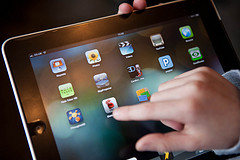As children look around their environment today, they are seeing not only the natural world, but also an increasingly technological world. For adults, this new world of technology makes possible instant connections between people, information, and ideas. But for parents of young children, who are often attracted to digital devices, it also raises questions and concerns about their children.
Many child development experts worry that too much time passively consuming entertainment media can limit a child's opportunities to play and interact with others, as well as contribute to health issues, such as obesity, by reducing the child's daily movement and exercise, while offering little value in return.
The good news is that there are many active and educational applications of technology that can be beneficial to children.
As a former teacher, parent, and grandparent, I have had to decide what is best for the children that I've worked with and care for.
For me, it all boils down to balance.
Children need a balance of activities, including lots of physical play and movement, non-screen-based learning and reading, and healthy routines for eating, sleeping and hygiene, along with age-appropriate, education-focused screen time with adult oversight and monitoring.
Education technology has a lot to offer our children. Digital resources can be very helpful for children's learning of language, concepts and skills. But for every appropriate and effective app or website, there are many more that are not quality programs or applications for children.
How do parents decide which education technology resource to use? Here are the questions I think parents should ask themselves (looking for as many yes answers as possible):
- Does it teach a particular objective? Does it help your child develop a language, reading or math skill?
- Is there an opportunity for your child to interact with the program and share what they are doing with others?
- Are there high-quality graphics? Are the pictures clearly illustrated with details that children can learn from?
- Is the print big enough for children to read easily?
- Is it voiced, so children can learn vocabulary, concepts and skills by listening?
- Is it engaging? Will your child use it more and learn more because it's fun?
- Does it promote thinking, creativity and play?
- Are there parent tips for the activities so that families can learn together?
Once they've decided to let a child use technology, adults should then continually monitor the child's use and, depending on the age, sit with him or her to establish a learning connection that will last. To get the most benefit from the experience, the adult should ask questions of the child.
Here are some examples:
- If your child is listening to nursery rhymes on a phone or tablet app, you could ask which words rhyme.
- If your child is counting numbers, you could ask him or her to show you the amounts for the numbers seen on the screen using real objects, such as pencils, blocks, or small toys.
- If your child is learning colors through an app, you could ask him or her to match a particular color to something in the room they are in.
- If your child is reading an online book, you could ask what the story is about, who is in the story, and where the story takes place. Asking your child to describe things and events in the story will help develop language skills.
Screen-based devices will continue to attract children, and high-quality education technology can offer engaging and effective learning experiences with those devices.
But what we need to remember as parents and teachers is that technology has limits. It is our job to create a supportive real-world learning environment, establish a daily routine that promotes learning, and regularly interact with our young learners in ways that will help them build their vocabulary and master other essential early learning concepts and skills.
It's when we help our children make connections between what they see and hear on the screen and the world around them that they learn best.
Rebecca A. Palacios, Ph.D., is a Senior Curriculum Advisor for Age of Learning, Inc., the company that operates ABCmouse.com.
